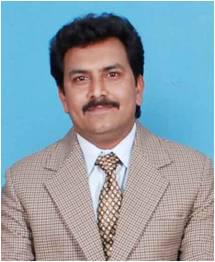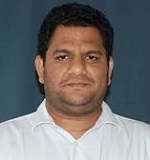Day 1 :
Keynote Forum
umesh patil
Dr. H.S. Gour Vishwavidyalaya, india
Keynote: Recent Challenges and Advances in Quality control & Standardization of Herbal products
Time : 10:00 - 11:00 Am

Biography:
Abstract:
The full potentials of the herbal products are mainly not utilized due to the insufficient knowledge of the holistic quality & chemical composition of most herbal products. The growth potentials of the herbal product industry can only be achieved if the composition of herbal product is standardized in order to ensure proper quality control and accountability. In recent years more people throughout world have realized to use herbal products in health care system. Worldwide need of alternative medicine has resulted in growth of herbal product markets and interest in traditional systems of medicine. Herbal drug technology is used for converting botanical materials into medicines, where standardization and quality control with proper integration of modern scientific techniques and traditional knowledge is important. In order to prove constant composition of herbal preparations, adequate analytical methods such as photometric analysis, thin layer chromatography, high performance liquid chromatography, gas chromatography, DNA fingerprinting and metabolomics are used. Phytochemical standardization encompasses all possible information generated with regard to the chemical constituents present in herbal products. In recent years World Health Organization and many herbal industries worldwide have emphasized on the importance of qualitative and quantitative methods for characterizing the samples, quantification of the biomarkers, chemical markers and the fingerprint profiles. If principle active components are known, it is most logical to quantify these compounds. My talk will cover current trends, challenges and advances in quality control and standardization of herbal products.
Keynote Forum
DR. AMBERKAR MOHANBABU VITTALRAO
MANIPAL UNIVERSITY (FORMERLY KNOWN AS MAHE
Keynote: Hepatoprotective activity of aqueous extract of Curcuma longa against Anti - tubercular drugs (ATT) induced hepatotoxicity in Wistar albino rats
Time : 11:20-11:50

Biography:
Abstract:
Objective: To evaluate the hepatoprotective activity of Curcuma longa (Cl) against ATT
induced hepatic damage in rats.
Materials and methods: The rhizomes of the plant were shade dried, powdered and extracted with water. Total 5 groups were used for the study wherein, Gr. I rats were treated with normal saline as a control (vehicle), Gr. II and III were given with hepatotoxic ATT drugs, isoniazid (INH) 31.5 mg/kg + rifampicin (RIF) 54 mg/kg + pyrazinamide (PZA) 189 mg/kg and silymarin
50mg/kg as standard hepatoprotective drug respectively. Gr. IV and V rats dosed with 100 and
200 mg/kg of Cl extract respectively. The plant Cl extract, ATT drugs and silymarin were prepared as suspensions with 2% gum acacia. Calculated daily dosage of (Cl extract +ATT drugs) were split and administered twice for 90 days. The Aqueous extracts of Cl and silymarin were administered orally every morning along with ATT drugs for 90 days. On 90th day, biochemical analysis was done by measuring serum liver enzymes, albumin and total proteins levels. The hepato-protective activities of Cl extract were further determined by the histopathological examination.
Results: A. biochemical analysis: ATT treated rats showed significant increase in AST (aspartate aminotransferases), ALT (alkaline liver transferase), ALP (alkaline liver phosphatases), and GGT (γ-glutamyl transferase) in the serum Vs. control (P<0.05). Treatment of silymarin and Cl (100 and 200 mg/kg) extract showed hepatoprotective activity against the hepatic damage induced by ATT. This was evident from significant reduction in serum liver enzymes levels ALT, AST, ALP, GGT and also there was significant increase in serum albumin and total proteins as compared to the ATT treated groups (P<0.05). B. Histopathology: ATT treated rats histopathological slides revealed mild-moderate fibrosis, low grade inflammation, hepatocellular necrosis with sinusoidal dilatations suggestive of congestion and significant hepato-protective changes were found when Cl extract was treated with ATT drugs.
Conclusions: The hepato-protective action combined with antioxidant activity has a synergistic effect to prevent the process of initiation and progress of hepatocellular damage. Thence, we conclude that aqueous extract of Cl is a promising hepato-protective agent could be clinically useful when added with ATT drugs.
Keynote Forum
Genevieve D. Tupas
Davao Medical School Foundation, Inc., Philippines
Keynote: Prospects of Developing Drugs from Natural Sources in a Resource-Poor Setting

Biography:
Dr. Genevieve D. Tupas is the Director of the Research and Publication Office and concurrently the Unit Head of the Research Center and Associate Professor 1 of Pharmacology Department of the College of Medicine, Davao Medical School Foundation Inc. Davao City, Philippines. She is a graduate of Master of Medicine (Clinical Epidemiology) at the University of Sydney, and a practicing pediatrician. Her research interests include natural products research, clinical epidemiology and their translation to benefit the community.
Abstract:
The process of developing a new drug for use in medical practice takes an average of 10 to 15 years at a staggering cost ranging from 800million to 1 billion USD. This leaves an impression that drug development can only be done by rich countries while the poor ones have no hope at all. The richness and diversity of flora and fauna all over the world speak about equitability and balance in opportunities. Developed countries are now reaching out to less developed ones offering trainings and skill transfer to help build the research capability of the latter. In return, developing countries offer their raw data and potential leads for further studies with fair sharing in intellectual properties towards novel drug development. Opportunities are available and these will be discussed in my talk. Additionally, some research processes can be streamlined according to the research capacity and capability of each institution in order to come up with innovative but useful products that can be readily utilized by the community with minimal cost of production.
Recent Publications
- Otero, MCB and Tupas, GD (2018). Phytochelatins and Heavy Metal Tolerance in Plants. In C. Egbuna (Ed.), Phytochemistry Vol 3: Marine, Industrial, and Advances. USA: Apple Academic Press.
- Raneses, G.M., Tupas, G.D., Guarino, D.V., Martinez,C., Marundan, J.A., Mascardo, K., Meling, R. K., Mendez, M., Monterde, K. A., Montojo, M.D. The Effect of ED90 Dose of Calabash (Crescentia cujete) Decoction on Blood Sugar Levels of Pre-Diabetic Individuals. Research Journal of the Davao Medical School Foundation, Inc. Vol. 3 (21-26) 2017.
- Nicole Shilkofski; Jill Edwardson; Ronke Adewale; Fides Ababon; Genevieve Tupas.Evaluation Of Simulation-Based Neonatal/Obstetric Resuscitation Training In A Resource-Poor Setting. Critical Care Medicine 44:89 · December 2016. DOI: 10.1097/01.ccm.0000508728.54815.a6
- Pizarro, R., Samanodi, B., Samson,M.,Santamaria, A., Solidum, M., Superioridad, J., Tan, J., Tocao, X., Ubaldo,C., San Juan, E., Tagle,M. Tupas, G. Antiglycation effects of Asparagus officinalis as an Adjunct Management for Metformin-treated Individuals with Type 2 Diabetes Mellitus. Poster Presentation, 15th Diabetes and Cardiovascular Risk Factor – East Meets West Symposium” Hong Kong Convention and Exhibition Centre, October 1, 2013. (Published in its Proceedings).
- Clarion. C., Bacquirel, S., Fernandez, C. J., Magno, J.A., Monfort, M.K., Nunez, K.W., Santiago, M.R., Sevilleno, M.S., Tuason, P.J., Villaflor, G.G., Yap, F.D.J., Lonzaga, R., Tupas, G., Tagle, M., San Juan, E., Nartatez, H. A Prospective Randomized Double-Blind Controlled Trial on the Effect of Centella asiatica Cream and Silver Sulfadiazine on Acute Superficial Wounds of Patients at Southern Philippines Medical Center. Research Journal of The Davao Medical School Foundation, Inc. Vol. 2 (39-50) 2013.
Keynote Forum
Kirankumar Hullatti
KLE College of Pharmacy, India
Keynote: Application of Quality by Design (QbD) approach in development of Herbal Drug Products

Biography:
Kirankumar Hullatti has experience of 16 years as academician and 5 years in herbal industry. The model proposed here is based on the several literatures and from the previous experience in herbal production. Several projects have been carried out using QbD model in assessing the quality of herbal raw materials. The proposed model helps the stakeholders such as researchers and industry in developing the quality herbal products. He has also received funding from Dept. of Science and Technology, GoK, India for project related to quality assessment of raw materials used in Ayurveda.
Abstract:
Abstract
Quality by Design (QbD) concept is a systematic approach towards development of product that begins with predefined objectives and emphasizes product and process understanding and process control, based on sound science and quality risk management. Recent pharmaceutical regulatory documents have stressed the critical importance of applying QbD principles for in-depth process understanding to ensure that product quality is built in from the onset of manufacturing process. The use of Herbal medicines is on rise all over the world due to their promising therapeutic effects and fewer adverse effects. This has led to phenomenal increase in the demand for herbal medicines in the last two decades. The manufacturing process for the herbal drug products is complex and involves many unit operations. It is therefore significant to develop manufacturing process under the framework of QbD, which aims to build the quality of herbal drug product from the onset of its manufacturing process.
The concept has been widely accepted and applied in the pharmaceutical manufacturing industry. There are still issues that need to be addressed in the implementation of QbD for Herbal drugs. Some of these issues discussed in the lecture are, variation in the quality of herbal raw material and identification of the correct source and such as extraction and suitable formulation, defining the critical quality attributes during development of herbal drug product. Therefore this presentation aims to give an brief information regarding the application of QbD principle to improve the process development and formulation of herbal drug product.
Recent Publications
- Mahesh Biradi and Kirankumar Hullatti, (2017) Bioactivity guided isolation of cytotoxic terpenoids and steroids from Premna serratifolia, Pharmaceutical Biology, Vol. 55, No. 1, 1375–1379
- Kirankumar Hullatti, Analee Rodrigues, Vinod Mannur, Vinayak Mastiholimath, and Vijay Kumar Rasal,(2016) Chemical Fingerprinting and Quantification of Biomarker Wedelolactone in Different Sources of “Bhringaraja” by High-Performance Thin-Layer Chromatography and Method Validation, Journal of Planar Chromatography, 29 (5), 330–335
- Telagari M. and Hullatti K. K., (2016) In Vitro Screening of Actiniopteris dichotoma For Enzyme Inhibitory Activity Related To Type 2 Diabetes, Indian Drugs, 53(06), 70-73
- Madhusudhan Telagari, Kirankumar Hullatti, In‑vitro α‑amylase and α‑glucosidase inhibitory activity of Adiantum caudatum Linn. and Celosia argentea Linn. extracts and fractions., Indian J Pharmacol 2015;47:425-9.
- Anil Kumar Raju Banappa S. Unger, Kirankumar Hullatti and Madhusudhan Telagari. Evaluation of anti asthmatic activity of hydro alcoholic extract of Citrullus colocynths and Cucumis trigonus fruits. J App Pharm Sci, 2015; 5 (08): 126-130.
Keynote Forum
Aya Abd Elsalam Abo Elola Shokry
Cairo University, Faculty of Veterinary Medicine, Department of Pharmacology
Keynote: Some phytochemical, toxicological and pharmacological studies on apricot seed (Armeniace Semen) extracts.

Biography:
Aya Abd Elsalam has completed the bachelor of veterinary medicine at the age of 21 years from Cairo University and completed pre-master studies from faculty of veterinary medicine Cairo University at 2017 and expected to finish the master at December 2018. She work as demonstrator at Pharmacology Department, Faculty of Veterinary Medicine, Cairo University
Abstract:
The present study was to investigate phytochemical, toxicological and some pharmacological activities of 70 %, 99.9% ethanolic extract of apricot seeds. The phytochemical screening was done for determination of total phenolics by the Folin–Ciocalteu method, total flavonoids by the aluminum chloride colorimetric method, total carotenoids and amygdalin content using HPLC. The toxicological studies was done for determination of LD50 in mice by oral administration of different doses of the extracts. The anti-inflammatory activity was done in vitro by determination of IC50 values for inhibition of the enzymes cyclooxygenase 1, 2 (COX-1, COX-2) and in vivo by formalin induced paw edema on rats. The analgesic activity was carried out on mice by writhing test and hot plate method. Phytochemical screening revealed that the amount of total phenolics was 179.4 and 191.2 ug gallic acid equivalent / g extract and the amount of total flavonoids was 226.18 and 509.34 ug rutin equivalent / g extract and the amount of total carotenoids was 0.145 and 0.156 mg/g extract and the amount of amygdalin was 5.72 g and 10.22 g / 100 g extract for 70 %, 99.9% ethanolic extract respectively. The toxicological studies revealed that both extracts has no toxic symptoms on rats , no mortalities appear on rats in different level of doses from 1 g to 10 g / kg BW. IC50 was 10.4, 0.33 and 7.45, 0.074 and 15.1, 0.049 Um for COX-1 and COX-2 for 70 %, 99.9% ethanolic extract, Celecoxib respectively. 70%, 99.9% ethanolic extract and amygdalin exhibited significant analgesic and anti-inflammatory activity in dose of 200 mg/kg BW. of both extracts and 50 mg/kg BW. for amygdalin.
Recent publications
- Baba, S. A. and Malik, S. A. (2015). Determination of total phenolic and flavonoid content, antimicrobial and antioxidant activity of a root extract of Arisaema jacquemontii Blume. Journal of Tilbian University for Science, 9(4), 449-454.
- Badr, J. and Tawfik, M. K. (2014). Analytical and Pharmacological Investigation of Amygdalin in Prunus armeniaca L. Seeds. Journal of Pharmacy Research, 3(9), 2134-2137.
- Bolarinwa, I.F., Orfila, C. and Morgan, M.R.A. (2014). Amygdalin content of seeds, seeds and food products commercially-available in the UK. Food Chemistry, 152, 133-139.
- Chang, H.K., Yang, H.Y., Lee, T.H., Shin, M.C., Lee, M.H., Shin, M.S., Kim, C.J., Kim, O.J., Hong, S.P. and Cho, S. (2005). Armeniacae semen extract suppresses lipopolysaccharide-induced expressions of cycloosygenase-2 and inducible nitric oxide synthase in mouse BV2 microglial cells. Biological and Pharmaceutical Bulletin, 28(3), 449-454.
- Hwang, H.J., Kim, P., Kim, C.J., Lee, H.J., Shim, I., Yin, C.S. and Hahm, D.H. (2008). Antinociceptive effect of amygdalin isolated from Prunus armeniaca on formalin-induced pain in rats. Biological and Pharmaceutical Bulletin, 31(8), 1559-1564.
- Hwang, H.J., Lee, H., Kim, C., Shim, I. and Hahm, D. (2008). Inhibitory Effect of Amygdalin on Lipopolysaccharide-Inducible TNF- α and IL-1 β mRNA Expression and Carrageenan-Induced Rat Arthritis. Journal of Microbiology and Biotechnology, 18(10), 1641-1647.
- Koo, J., Hwang, E., Cho, S., Lee, J., Lee, Y. and Hong, S. (2005). Quantitative determination of amygdalin epimers from armeniacae semen by liquid chromatography. Journal of Chromatography B, 814, 69-73.
- Korekar, G., Stobdan, T., Arora, R., Yadav, A. and Singh, S.B. (2011). Antioxidant Capacity and Phenolics Content of Apricot (Prunus armeniaca L.) Seed as a Function of Genotype. Plant Foods for Human Nutrition, 66, 376-383.
- Minaiyan, M., Ghannadi, A., Asadi, M., Etemad, M. and Mahzouni, P. (2014). Anti-inflammatory effect of Prunus armeniaca L.(Apricot) extracts ameliorates TNBS-induced ulcerative colitis in rats. Research in Pharmaceutical Sciences, 9(4), 225-231.
- Pradelles, P., Grassi, J. and Maclouf, J. (1985). Enzyme immunoassays of eicosanoids using acetylcholine esterase as label: An alternative to radioimmunoassay. Analytical Chemistry, 57(7), 1170-1173.
Keynote Forum
Vinodh Kumar S Mannur
KLE College of Pharmacy, India
Keynote: Challenges in Implementing Quality By Design (QbD) in the development of herbal products

Biography:
Dr. Vinodh Kumar S Mannur has experience of 18 years as academician and has delivered the topics related to “Quality by Design (QBD)” as guest speaker at various conferences. The model proposed here is based on several literatures and his previous experience in pharmaceutical and herbal product development and formulations. He has carried out various research projects using QbD concepts which is based on Joseph Moses Juran foundation to the concept of quality by design. It emphasise to understand critical quality attributes of the materialas and process parameters to perform risk assessment during the product development in establishing control stratigies using design of experint studies in order to attain quality target product profile. The proposed model benefits the research scholars and herbal industry to fulfil the regulatory requirements in promoting the quality herbal products with high throughput.
Email: vsmannur72@gmail.com
Abstract:
A review of the regulatory status of herbal drugs/products was done for few countries. A critical assessment was done, to know the hindrances in the process of harmonization of herbal products. It has been found that there is a lack of harmonization in the regulatory requirements of herbal products internationally, besides the issues of availability of herbs and their conservation. Quality by design is a crucial part of the modern approach to pharmaceutical quality. “Quality could be planned and most of quality deficit arises in the way process is planned and developed”, this thought of well-known quality expert Joseph Moses Juran gives foundation to the concept of quality by design (QbD). It refers to a new approach to product development that could increase efficiencies, provide regulatory relief and flexibility. Recently, the US Food and Drug Administration introduced quality by design (QbD) as a fundamental pharmaceutical quality model to be considered in the process and product development of pharmaceuticals. QbD concept has been supported by International Conference on Harmonisation (ICH) guidelines Q8 (R2). The beneficial impact of herbs on human health have been used for centuries and widely accepted by patients to the present day. The efï¬cacy of herbal drugs often results from a complex composition of substances. The complexity of herbal drugs is the major reason for the lack of satisfactory studies into their effect and causes problems for the deï¬nition and assurance of quality. The implementation of QbD enables robust manufacturing process, and facilitate product quality. Herbs have in general a broad variety of compounds depending on growth and harvesting conditions. A suitable process design rated by the QbD principals can ensures a robust process from extraction to puriï¬cation of herbal drugs in spite of their complex nature. Quality by Design is a powerful development approach that offers a number of technical, quality, and regulatory dividends. Hence application of quality by design (QbD) for development of herbal drugs can give rise to improved understanding of process which in turn will facilitate proper identification of sources of variation, management of variability by process design, and prediction of product quality attributes.
Keynote Forum
Maria Catherine B. Otero
Davao Medical School Foundation, Inc., Philippines
Keynote: Trends in Assessing Antimicrobial Activity of Plant Extracts in the Philippines

Biography:
Maria Catherine B. Otero currently the Coordinator of the Office of Research and Publication, and Research Coordinator for the College of Medicine Research Center at the Davao Medical School Foundation, Inc. She is a graduate of Master of Science in Public Health (Medical Microbiology) under the Virology track from the University of the Philippines Manila. Her fields of interest span microbiology and molecular biology, epidemiology of Chikungunya, Rabies and Rotaviruses, natural products research, and their translation to benefit the community.
Email: mcbotero@email.dmsf.edu.ph
Abstract:
agents from natural products continues to be an important field in the face of multi-drug resistance and re-emerging infections. Many studies in the Philippines have reported plant products that have antimicrobial potential. However, a huge gap in the natural products-based antimicrobial research in the Philippines remains in terms of studying antimicrobial mechanisms of action. This scoping study aimed to document the antimicrobial assessment methodologies employed by natural products researchers in the Philippines. Methodology and Theoretical Orientation: Published scientific articles were searched in databases like Google Scholar and HERDIN using the keywords antimicrobial+plants+ Philippines, antibacterial+plants+Philippines, antifungal+plants+ Philippines. Outputs of research laboratories in HEIs in Mindanao that perform natural products research were also given special attention. Findings: Initial results show that Disk Diffusion Assays are routinely used to screen for antimicrobials from crude extracts. Very few papers report using Disk Diffusion Assay guided by TLC bioautography. MIC determination by broth macrodilution is common. MIC-MBC determination was also reported. No studies on mechanisms of action (e.g. using flow cytofluorometry, effects on MDT) were found. Conclusion and Significance: The nature of published antimicrobials research from natural products in the Philippines is limited to early-stage establishment of antimicrobial potential. Studies that elucidate the mechanisms of action of these antimicrobials must be undertaken, with appropriate infrastructure and funding support, to complete the development of antimicrobial products.
Recent publications (minimum 5)
1. Otero, MCB and Tupas, GD (2018). Phytochelatins and heavy metal tolerance in plants. In C. Egbuna (Ed.), Phytochemistry Vol 3: Marine, Industrial, and Advances. USA: Apple Academic Press.
2. Otero, MCB (2017). Detection of Chikungunya Virus Infection in Monkeys from the Davao Region (Unpublished master’s thesis). University of the Philippines Manila, Manila, Philippines.
3. Murao, LAE, Alviola, IV, PA, Otero, MCB, Gilles, PG, Ladera, YSL, Lagat, FT, and Opondo, NB. (2017, July). Identification of risk factors for rotavirus circulation in pigs from Philippine backyard farms. Paper presented at the International Union of Microbiological Societies Congresses, Singapore.
4. Otero, MCB, Sy, AK, Tandoc, III, AO, Puentespina, Jr., RP, and Sarol, LDC. (2017, July). Sylvatic Chikungunya in Philippine macaques (Macaca fascicularis) from the Davao region. Poster presented at the International Union of Microbiological Societies Congresses. Singapore: IUMS Congresses 2017. IUMS2017-2682.
Otero, MCB and Puentespina, Jr., RP, Sy, AK, Tandoc, III, AO, and Sarol, LDC. (2017, May). Capture strategies for captive and wild Philippine macaques. Paper presented at the 29th PALAS Annual Scientific Conference. Pasig City, Philippines
Keynote Forum
Malleswara Rao Peram
Central Research Laboratory, MM Group of Institutions, India
Keynote: Enhanced cellular uptake and cytotoxic potential of curcumin loaded nanovesicular formulations on A375 human melanoma cells

Biography:
Malleswara Rao Peram is working as Associate Professor at Department of Pharmaceutics, Maratha Mandal College of Pharmacy, Belagavi, India. He did his Ph.D. in pharmaceutical sciences from KLE Academy of Higher Education and Research, Belagavi, India. He has his expertise in the field of nanovesicular carrier systems like liposomes, ethosomes and transfersomes for topical and transdermal applications. His research interest includes development of novel drug delivery systems for natural products. In addition, he has key skills in the analytical method development and validation for pharmaceutical drugs and herbal products.
Email: pvsnmallesh@gmail.com
Abstract:
Statement of the Problem: Melanoma is the most fatal and life threatening type of skin cancer with increasingly higher rates of occurrence worldwide. Although it accounts for 1% of all skin cancers, most of the skin cancer related deaths (75%) occur due to melanoma. Despite extensive clinical research, only few drugs have been approved by United States Food and Drug Administration (USFDA) for melanoma therapy. Most of these drugs kill normal healthy cells besides cancer cells. At present, the overall success rate of current modalities for this chemoresistant and metastatic melanoma is rather restricted. Hence there is an intense need for natural compounds, which can precisely treat melanoma with little or no toxicity on normal cells and prevent its progression to metastatic stage. The objective of the present study is to develop, optimize and evaluate curcumin loaded nanovesicular formulations for the treatment of melanoma. Methodology: The curcumin loaded nanovesicles (ethosomes and transfersomes) were prepared by cold and thin film hydration method respectively. The prepared nanovesicles were evaluated for size, zeta potential, entrapment efficiency, in vitro skin permeation and deposition studies. The optimized formulations were evaluated for in vitro cytotoxicity and cellular uptake studies using A375 human melanoma cells. Findings: The optimized nanovesicular formulations were found to be spherical and unilamellar structures having nanometric size range and high entrapment efficiency. The curcumin loaded nanovesicles showed significant skin permeation and deposition in the skin layers. The fluorescence microscopy study confirmed the enhanced penetration of nanovesicles into the deeper skin layers. The in vitro cytotoxicity and cellular uptake studies revealed that curcumin ethosomes had significantly improved cytotoxicity and cellular uptake in A375 human melanoma cell lines. Conclusion & Significance: The present study provides a strong rationale for further investigation of newly developed curcumin nanovesicular formulations as a potential therapeutic strategy for melanoma treatment
Curcumin loaded nanovesicles: Formulation, characterization, in vitro cytotoxicity and cellular uptake studies against A375 human melanoma cell lines
Recent publications (minimum 5)
- Mirzaei H, Naseri G, Rezaee R, Mohammadi M, Banikazemi Z, Mirzaei HR, Salehi H, Peyvandi M, Pawelek JM, Sahebkar A (2016). Curcumin: A new candidate for melanoma therapy?. International journal of cancer. 139(8):1683-1695.
- Zhang YP, Li YQ, Lv YT, Wang JM (2015). Effect of curcumin on the proliferation, apoptosis, migration, and invasion of human melanoma A375 cells. Genetics and Molecular Research 14(1):1056-1067.
- Yu X, Du L, Li Y, Fu G, Jin Y. (2015). Improved anti-melanoma effect of a transdermal mitoxantrone ethosome gel. Biomedicine & Pharmacotherapy, 73, 6-11.
- Sun Y, Du L, Liu Y, Li X, Li M, Jin Y, Qian X (2014). Transdermal delivery of the in situ hydrogels of curcumin and its inclusion complexes of hydroxypropyl-β-cyclodextrin for melanoma treatment. International Journal of Pharmaceutics. 469(1):31-39.
- Faisal W, Soliman GM, Hamdan AM (2018). Enhanced skin deposition and delivery of voriconazole using ethosomal preparations. Journal of Liposome Research. 28(1):14-21
